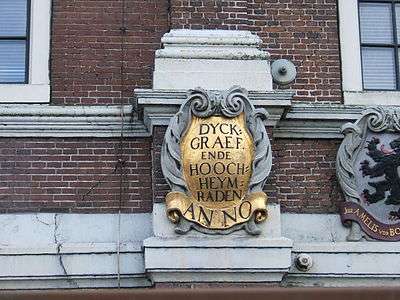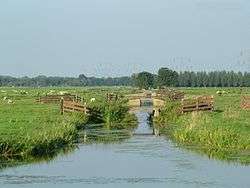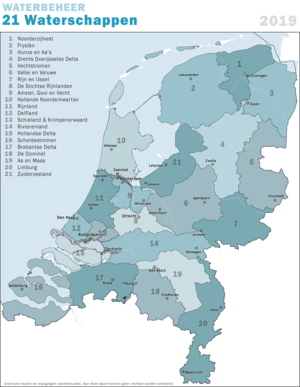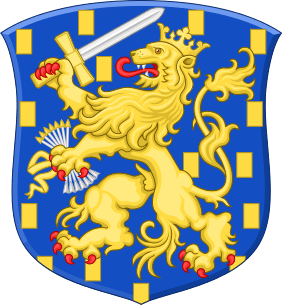Water board (Netherlands)
Dutch water boards (Dutch: waterschappen or hoogheemraadschappen) are regional government bodies charged with managing water barriers, waterways, water levels, water quality and sewage treatment in their respective regions. These regional water authorities are among the oldest forms of local government in the Netherlands, some of them having been founded in the 13th century.

Around 26 percent of the area of the Netherlands is at or below sea level[1] and several branches of the Rhine-Meuse-Scheldt delta run through this relatively small country. Historically there always was a good deal of coastal and river flooding. Flood control in the Netherlands is a national priority, since about two thirds of the country is vulnerable to flooding, while at the same time it is one of the most densely populated areas on Earth. Natural sand dunes and man-made dikes, dams and floodgates provide defense against storm surges from the sea. River dikes prevent flooding of land by the major rivers Rhine and Meuse, while a complicated system of drainage ditches, canals and pumping stations (historically: windmills) keep the low-lying parts dry for habitation and agriculture. Water boards are independent local government bodies responsible for maintaining this system.
An Unie van Waterschappen (the association of Dutch regional water authorities, referring to itself as Dutch Water Authorities)[2] promotes the interests of Dutch water boards at a national and international level. All 21 water boards are members of this association. The Unie van Waterschappen acts collaboratively with other appropriate bodies or institutions to pursue the Association's objectives. It is a member of the European Union of Water Management Associations (EUWMA).[3]
History
Origins and early development

This method of controlling water emerged as the unpredictable water was tamed and the land drained for agriculture. The first dikes and water control structures were built and maintained by those directly benefiting from them, mostly farmers. As the structures got more extensive and complex, councils were formed from people with a common interest in control of water levels of their land. The first water boards were formed in the 13th century. These often controlled only a small area, a single polder or dike.
As these boards became better organised, the counts of Holland began granting charters to the boards. They were also granted the right to make their own bylaws. The ever-present threat of loss of life and land required short lines of communication between authorities and residents who maintained the infrastructure. The threat of flooding in a heerlijkheid was best dealt with by local authorities, so water boards were originally chaired by the local nobility.
Local water boards were set up to maintain integrity of water defences around local polders, to maintain waterways inside polders and to control various water levels in and outside local polders. The mandate of these water boards (which remains largely unchanged) was maintenance of dikes, dunes and waterways (and roads too, in several municipalities), control of water level and quality of all surface water (including punishing polluters). The original water boards varied much in organisation, power and area they managed. The differences were often dictated by different circumstances, whether they had to defend a sea dike against a storm surge or keep water level in a polder within bounds. Hoogheemraadschappen were responsible for protecting the land against the sea and for regulating water levels of various canals and lakes into which water was pumped from polders and waterschappen.
Dikes were maintained by individuals who benefited from their existence, every farmer was designated a part of a dike to maintain, with a review every three years by the water board directors. The old rule was "Whom the water harms stops the water" (Dutch: Wie het water deert, die het water keert). This meant that those living at the dike had to pay and care for it. Those people could go bankrupt from having to repair a breached dike. Those living further inland often refused to pay for or assist upkeep of dikes, even though they were just as much affected by floods. This system led to haphazard maintenance and it is believed that many floods would be prevented or mitigated if dikes had been in better condition.[4]
Punishments meted out by water boards were fines for misdemeanors such as emptying waste in the nearest canal; however, according to various historical documents, the death penalty was used more than once for serious offenders who threatened dike safety or water quality.[5]
Later development
.jpg)
In the 17th century there were many of these independent local bodies levying their own taxes and administering justice. This early form of local government played a role in the development of a political system in the Netherlands that was decentralised and dependent on communal cooperation. Widespread experience with decentralized government was a factor in the formation of the Dutch Republic in the 16th and 17th centuries.[6]
The mandate of Rijkswaterstaat (English: Directorate General for Public Works and Water Management), established in 1798 under French rule, was to centralise water control in the Netherlands. Local water boards refused to give up their autonomy however, so Rijkswaterstaat ended up working alongside the local water boards. Today Rijkswaterstaat has responsibility for major water control structures and other infrastructure like motorways.
By 1850 there were about 3,500 water boards in the country.[7] In modern times water boards merged as they dealt with joint (and sometimes conflicting) interests. Mergers eventually reduced the number to 25 water boards in 2011.[8]
The tasks of water boards remain basically unchanged. Having a rich history dating back to the Middle Ages, they are the oldest governing bodies and the oldest democratic institutions in the Netherlands. Dutch water boards have their own coat of arms, a colourful reminder of their importance in Dutch history. The historic buildings that used to house the water boards are another legacy. Called gemeenlandshuis or waterschaphuis, these charming old buildings can be found at the heart of many Dutch towns.
Responsibilities

Water boards act independently from national government to manage the continuing struggle against the water in the Netherlands. Water boards still levy their own taxes, they also have the authority to penalize offenders through means of administrative fines. To control quality of surface water (canals, lakes, ponds and streams), water boards fulfill several tasks: policy making, planning and building projects, issuing permits (sewage discharge requires a permit) and treatment of sewage and by-products. The various municipalities within the geographic area covered by a water board are responsible for collecting sewage from households and industries, but water boards transport and treat the sewage.

In its territory a water board is responsible for:
- management and maintenance of water barriers: dunes, dikes, quays and levees;
- management and maintenance of waterways;
- maintenance of a proper water level in polders and waterways;
- maintenance of surface water quality through wastewater treatment.
Dutch water boards are not responsible for the water supply to the general public and are therefore not considered a utility.[9]
In addition to taxes raised by water boards, central government contributes to their finances by paying construction and maintenance costs of water barriers and main waterways. The costs of waste water treatment are financed by a water pollution levy, which is based on the polluter pays principle.
Governance
Water boards hold elections, levy taxes and function independently from other government bodies. Water board structures vary, but they each have an elected general administrative body, an executive board and a chair.
Hoofdingelanden
Most of the members of the general administrative body of the water boards (the hoofdingelanden) are elected democratically, although some stakeholders (e.g. agrarian interests) may have the power to appoint members. Members of the general administrative body are elected for a period of four years.
The constituencies of members of the general administrative body are the various categories of stakeholders: landholders, leaseholders, owners of buildings, companies and all residents. The nature of the interest and financial contribution are factors in determining how many representatives each category may have on the water board.
(Hoog)heemraden
The general administrative body elects some of its own members to sit on the executive board, called the college van dijkgraaf en heemraden. Except for the chairperson (the dijkgraaf, see below) these executive board members, called heemraden or hoogheemraden in Dutch, traditionally represent five types of water users: the local population (residents), industry (factories and industrial buildings), municipalities (urban areas), farmers (agricultural land), and public parks.
Dijkgraaf
Each water board is headed by a chair (dijkgraaf, literally: "dike count", but sometimes called "dike reeve" or "dike warden" in English), an ancient office that dates back to the medieval period. The chair is appointed by the government for a period of six years. The chair presides over the executive board and the general administrative body and has certain ceremonial duties as well. The chair of a water board is at the same level as a mayor in local government and a king's commissioner in provincial government.
List of water boards

Typically, a water board’s territory is made up of one or more polders or watersheds. The territory of a water board generally covers several municipalities and may even include areas in two or more provinces. As of 2018, there are 21 water boards in The Netherlands. [10]
- Waterschap Noorderzijlvest (Groningen, Friesland and Drenthe)
- Wetterskip Fryslân (Friesland and Groningen)
- Waterschap Hunze en Aa's (Groningen and Drenthe)
- Waterschap Drents Overijsselse Delta (Drenthe and Overijssel)
- Waterschap Vechtstromen (Drenthe and Overijssel)
- Waterschap Vallei en Veluwe (Utrecht and Gelderland)
- Waterschap Rijn en IJssel (Gelderland)
- Hoogheemraadschap De Stichtse Rijnlanden (Utrecht and South Holland)
- Waterschap Amstel, Gooi en Vecht (North Holland, Utrecht and South Holland)
- Hoogheemraadschap Hollands Noorderkwartier (North Holland)
- Hoogheemraadschap van Rijnland (South Holland and North Holland)
- Hoogheemraadschap van Delfland (South Holland)
- Hoogheemraadschap van Schieland en de Krimpenerwaard (South Holland)
- Waterschap Rivierenland (South Holland, Gelderland and North Brabant)
- Waterschap Hollandse Delta (South Holland)
- Waterschap Scheldestromen (Zeeland)
- Waterschap Brabantse Delta (North Brabant)
- Waterschap De Dommel (North Brabant)
- Waterschap Aa en Maas (North Brabant)
- Waterschap Limburg (Limburg)
- Waterschap Zuiderzeeland (Flevoland)
Elections
Anyone who is aged 18 or over and is registered with a local authority in the Netherlands can vote in the Water Authority elections, which are held every four years on the same day as the provincial government elections. The last elections were held on March 20, 2019. Prior to the vote, the local council posts each voter a list of candidates, a ballot paper and details of their local polling stations.
Nomenclature
Historical terms
Historically, the name hoogheemraadschap was used for a large area comprising a number of smaller waterschappen within its jurisdiction.[11] Hoogheemraadschap was also traditionally the word used for water boards located along the Rijn and the Vecht.[12]
The term waterschap refers to the jurisdiction or to the administrative body. This also applies to hoogheemraadschap. In Dutch, the plural of waterschap is waterschappen. The plural of hoogheemraadschap is hoogheemraadschappen. In present-day usage, the official term is waterschap. However, the word hoogheemraadschap is still used by some Dutch water boards for historical reasons or when several waterschappen are grouped together into a larger regional body.
Officially there is no difference between a hoogheemraadschap and a waterschap. The Water Board Act (Waterschapswet), the Dutch statute that governs regional water authorities, only uses the word waterschap.[13] A Dutch water board that still uses hoogheemraadschap in its name (e.g. the Hoogheemraadschap van Delfland) may have chosen to do so because hoogheemraadschap was part of the historical name. However, a waterschap that styles itself as a hoogheemraadschap no longer has its traditional structure with subordinate waterschappen. They have been merged into the hoogheemraadschap itself.[14] Some water boards chose the name hoogheemraadschap after a merger of a number of waterschappen into a larger one (e.g. Hoogheemraadschap De Stichtse Rijnlanden). When used in this sense, the word hoogheemraadschap refers to a large regional waterschap.
English translation
When referring to the administrative body, English translations of waterschap are "water board", "water control board", "district water board" or "regional water authority", the last word being recently adopted by the water boards as a preferred English translation on grounds that it is less ambiguous. The jurisdiction of a Dutch regional water authority is generally referred to as the "water board district" or "regional water authority district". These translations also apply to hoogheemraadschap, which is translated in the same way as waterschap.
The term "water board" or "regional water authority" may be confusing in the Dutch context, as water boards and regional water authorities in other countries are often responsible for water supply. A waterschap or hoogheemraadschap in the Netherlands is charged with the control and management of water as well as treatment of waste water, but not with water supply.
See also
| Wikimedia Commons has media related to Water boards in the Netherlands. |
- Gemeenlandshuis
- Dijkgraaf
- Heemraad
- Flood control in the Netherlands
- Floods in the Netherlands
References
- "Correction wording flood risks for the Netherlands in IPCC report". PBL Netherlands Environmental Assessment Agency. Retrieved 7 October 2017.
- Dutch Water Authorities
- "European Union of Water Management Associations (EUWMA)". EUWMA. Retrieved 7 October 2017.
- Bosker, F (2008). "Zeedijken in het noorden, Mythes en feiten over 2000 jaar kustbescherming", uitgeverij Noordboek, ISBN 978-90-330-0751-4
- "Branding iron still in the possession of the Hoogheemraadschap van Rijnland". library.wur.nl. Archived from the original on 10 July 2012.
- Raadschelders, J.C.N.; Th.A.J. Toonen, eds. (1993). Waterschappen in Nederland: een bestuurskundige verkenning van de institutionele ontwikkeling (Water boards in the Netherlands: a management inquiry into the institutional development). Hilversum: Verloren b.v. ISBN 90-6550-365-X.
- "Website for the Regional Water Authority of Salland". wgs.nl. Archived from the original on 22 June 2011.
- "Archived copy". Archived from the original on 2 November 2012. Retrieved 28 February 2012.CS1 maint: archived copy as title (link)
- "Website of Hoogheemraadschap van Rijnland". rijnland.net. Archived from the original on 6 May 2009.
- "Zoek Waterschap". waterschappen.nl. Retrieved 11 September 2018.
- B. Dolfing, Vroegste ontwikkelingen in het Waterschap, in: J.C.N. Raadschelders and Th.A.J. Toonen (Eds.), Waterschappen in Nederland: een bestuurskundige verkenning van de institutionele ontwikkeling, Uitgeverij Verloren, Hilversum (1993), pp. 76 ff. (in Dutch)
- What's in a name (in Dutch)
- Waterschapswet (in Dutch). Accessed 2008-08-13
- Hoogheemraadschap van Delfland (in Dutch) Accessed 2008-08-11
